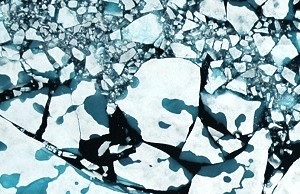Forecasting problems could put Arctic shipping plans on ice
Release Date 28 October 2014

Shipping industry plans to make use of ice-free Arctic waters could be set back by new research showing more accurate sea ice forecasts could still be years away.
Declining levels of summer sea ice have opened up the Arctic for commercial shipping and tourist cruises when the ice is at its lowest. However, plans to expand Arctic shipping routes, as well as oil and gas exploration, could be made more difficult by findings by climate scientists at the University of Reading.
They found that measurements of ice thickness are crucial for accurate forecasts of where ice will melt each summer.
However, even the most modern satellites measuring ice thickness - such as the European Space Agency's CryoSat2 spacecraft, which launched in 2010 - are unable to make the required measurements during the summer, as pools of melted water on the surface of the ice confuse its onboard instruments.
Lead researcher Dr Jonny Day said: "'Global warming is heating up the Arctic and the amount of summer ice is much reduced compared to a few decades ago. This has opened up not only new potential shipping routes but the possibility that energy companies could get access to vast oil reserves, thought to buried below the ocean floor.
"Because sailing through sea ice can be dangerous, slow going and consume large amounts of fuel, shipping companies may benefit from accurate advance warning of where the ice is going to melt, to show where the open water will be or where icebreakers could force their way through.
"This would require more accurate forecasts than scientists can currently provide. We've now shown that information about the thickness of the ice is crucial to providing better forecasts several months in advance. But even the latest satellites are incapable of providing this information between May and October, when end users are most in need of good forecasts.
"Finding a way to fill this gap may require new satellite technology or measurement techniques which could still be years away."
The research was carried out by scientists at the National Centre for Atmospheric Science (NCAS), at the University of Reading, and published in the journal Geophysical Research Letters.
Dr Ed Hawkins, University of Reading, one of the co-authors of the paper, said: "While we have highlighted a gap in our ability to make reliable forecasts at the moment, better measurements of ice thickness could improve forecasts.
"Satellites have revolutionised our understanding of the poles, but they still can't measure everything from hundreds of miles above the surface. We need a diverse array of technologies to provide the whole picture - from improved satellites to old-fashioned manual measurements."
The rapidly declining levels of ice in the Arctic has led to a growing scientific interest in Arctic ice forecasts. One system, developed by a University of Reading team led by Professor Daniel Feltham, used the number of melt ponds - so problematic for satellite measurements of ice thickness - to predict the minimum summer extent of sea ice several months in advance with an unprecedented level of accuracy. But even this system is incapable of making predictions showing where and when the ice will melt with the precision required for shipping.
The new research is part of the Arctic Research Programme, a £15m programme to enhance the UK's research effort in the Arctic, funded by the Natural Environment Research Council (NERC).
----
Reference: J. J. Day, E. Hawkins and S. Tietsche (2014) ‘Will Arctic sea ice thickness initialization improve seasonal forecast skill?', Geophysical Research Letters, DOI: 10.1002/2014GL061694
Available from: http://onlinelibrary.wiley.com/doi/10.1002/2014GL061694/abstract
The Arctic Research Programme, funded by the Natural Environment Research Council (NERC) addresses specific topics of scientific uncertainty in the Arctic region and is co-ordinated and managed at the British Antarctic Survey. The £15m research effort is working over a five-year period to address key questions about what is behind the environmental changes occurring in the Arctic and how they can impact on levels of greenhouse gas, and influence extreme weather events in the future. www.arp.arctic.ac.uk